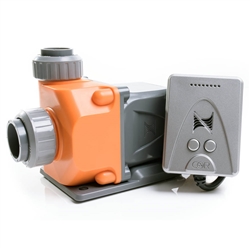Why use a DC Aquarium Return Pump?
|
Quiet? Energy Efficient?
Controllable? Why not?
|

|
In recent years aquarium hobbyists have been replacing traditional AC powered aquarium return pumps with DC aquarium return pumps. DC pumps use direct current rather than alternating current, which gives them a few advantages over more traditional aquarium pumps. Here are some of the reasons to consider a DC pump over an AC pump.
Noise – DC pumps are considerably quieter than AC pumps. Some DC pumps such as the
Reef Octopus VarioS are nearly inaudible. Silence can help you focus on what’s in the tank rather than what’s on the tank. Keep in mind that while the motor noise of a pump can be silenced, the sound of moving or splashing water will still remain.
Energy Efficiency – DC pumps use considerably less energy than AC pumps. While energy consumption may not be a big concern to the aquarist with a 30 gallon tank, it’s a big issue for the owner of a 300 gallon tank. The electric bill can be one of the most expensive parts of maintaining a tank. For example, a Supreme Mag Drive 18 has a flow rate of 1,325 gph and uses 150 watts of power, but a
Neptune Systems COR 15 Intelligent Return Pump moves 1,500 gph and uses less than 50 watts. In general, DC pumps use less than a third as much electricity to move a given amount of water as AC pumps.
Controllability - DC pumps can be controlled by an included controller or third party controller. What are the advantages of controllability?
Sizing – You may move up to a bigger tank or down to a smaller tank in the future. When you buy a DC pump you can always dial down the pump speed if it’s too much. Because the pump speed is slowed down with a controller, and not a valve, slowing down a DC pump will also reduce the pump’s power consumption and noise level. You can reduce the flow with an AC pump using a valve, but you will use the same amount of power and many pumps can get louder as the flow is restricted.
Functionality - When connecting a DC pump to a third party controller, such as a
Neptune Apex, DC pumps can be set to slowly ramp up or quickly pulse to create waves that recreate ocean-like currents. They can be set to run quickly during the day and slowly at night so you can sleep more easily. When feeding your fish you can set your DC pump to run slowly so the fish can eat without food being drawn into the filter. The pump can be sped up afterwards to suck the remaining food into the filter.
WildCard, New AC Pumps – With all of these advances in DC pump technology a couple manufactures have worked hard to upgrade their AC pumps. Hydor makes
Seltz D pumps that have feed modes as well as push button speed control built into the pump.
Rossmont Riser & Riser RX Return Pumps use extra thick silicon sound absorbers to reduce the noise levels to close to that of DC pumps, along with well designed Italian made motors that are nearly as efficient as DC pumps, but at a lower price point. Rossmont pumps can also be controlled with the
Rossmont Waver controller allowing you to control the pump speed from your smart phone or tablet.
If you’re considering a new pump, or looking to replace an old one, make sure to consider a DC pump or more modern AC pump. With high quality pumps you can have a more enjoyable, affordable, and healthy aquarium.




























